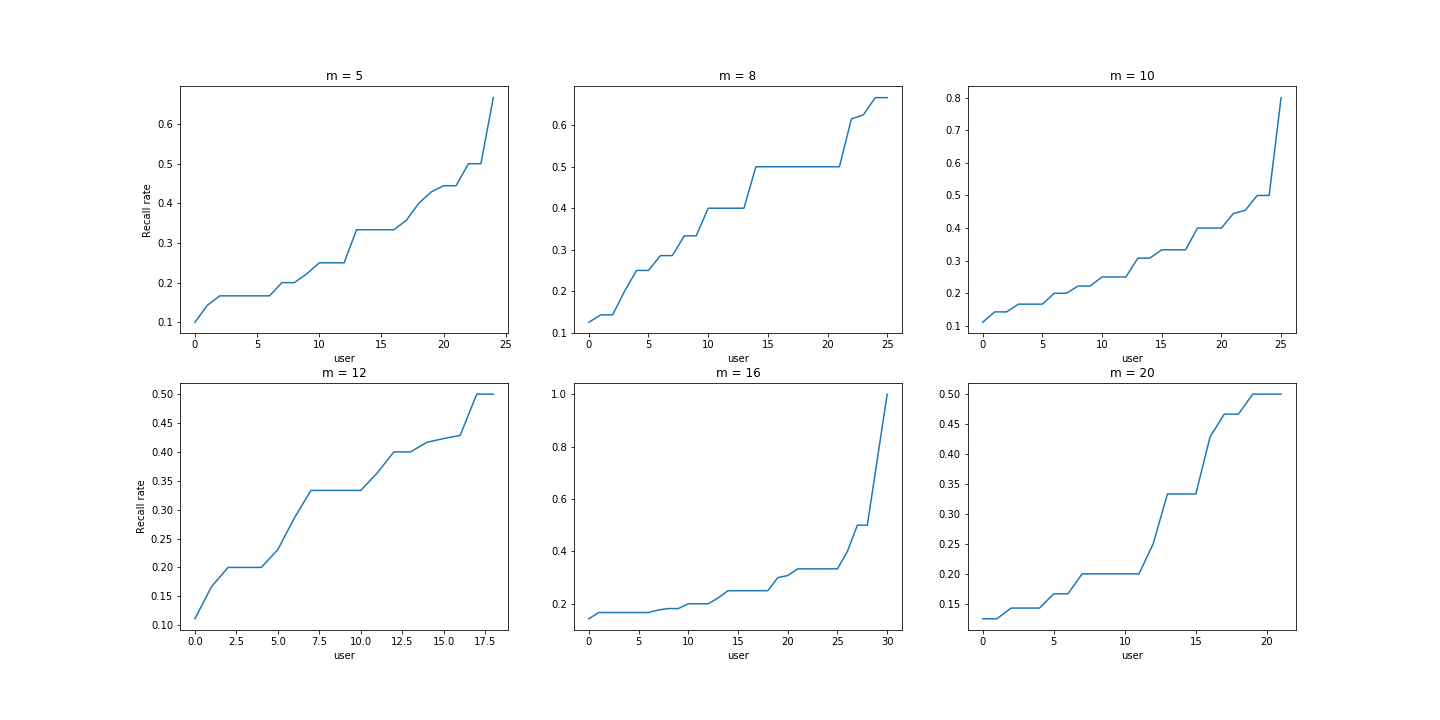|
|
数据处理部分
- 电影间的依赖关系:使用networkx随机生成有向无环图,共生成10个有向无环图,根据生成的图可以生成业务矩阵:
|
|

数据处理过程
- 电影选取:统计数据集中每部电影被用户交互过的次数,从大到小排序,从交互比较稠密的前200个电影中随机抽取152部。 根据选取出的152部电影选出交互过这些电影是用户,如果用户交互过的所有电影的负样本的交集为空,则不选择该用户;并且,每个用户交互过的电影必须大于4个,防止用户交互信息过于稀疏。
- 生成用户行为数据:根据选出的用户和其交互过的电影信息,生成[用户id,业务id,评分,上一次交互id,时间戳] 格式的行为数据,上一层交互id不存在用-1代替,业务id即是152个电影id。
- 将选出的电影特征做处理,将电影上映年份、种类处理为one hot向量。 将用户信息的邮政编码归一化处理,将用户的性别、职业、年龄等信息处理为 one hot 向量。
- 将电影标题使用bert_as_service生成1x768的句子向量,给定一个在一定单词数在一定范围内的句子,bert as service能生成该句子的1x768的向量。
- 编写DataInput类,用于将行为数据中的用户id和用户信息(职业性别等向量)、电影id和电影信息(电影类型、发行年份的one hot向量,bert句子向量等)关联起来,生成一条样本数据。编写next_batc()方法用于生产下一批次的样本数据,作为模型的输入,next_batc()函数用参数isTrain来判断当前的next batch是训练数据还是测试数据。
模型部分
模型如图所示

-
在忽略batch size的情况下,用户信息的输入tensor为 1x30;正样本的输入tensor为 2 * 796,2是lstm cell输入的max time,即是有2个时间序列,表示电影依赖关系a->b的序列,796中的768是电影标题的句子向量,剩下的28是电影种类、发行年份的one hot 向量;负样本的输入仅仅是一个电影的信息向量,1x796。
-
封装tensorflow的全连接层函数:
1 2 3 4 5 6 7 8 9 10 11 12 13 14 15 16 17 18 19 20 21 22 23 24 25 26 27 28def add_dense(input_tensor, output_size, layer_name, keep_prob=1.0, activation_function=None, reuse=False): '''添加一个全连接层。 输入的tensor,输出的维度,层的名字 ''' #获得tensor的列数(shape的第二个维度) input_cloumn = input_tensor.get_shape()[1] #计算dropout_rate # dropout_rate = 1.0 - keep_prob with tf.variable_scope('dense_layer_' + layer_name, reuse=reuse): weights = tf.get_variable('weights', [input_cloumn, output_size], initializer=tf.truncated_normal_initializer(stddev=0.1)) biases = tf.get_variable('biases', [output_size], initializer=tf.constant_initializer(0.0001)) variable_summaries(weights, layer_name + '_weights') variable_summaries(biases, layer_name + '_biases') mul_op = tf.matmul(input_tensor, weights) + biases output_tensor = None if activation_function == None: output_tensor = mul_op else: output_tensor = activation_function(mul_op) if keep_prob != 1.0: output_tensor = tf.nn.dropout(output_tensor, keep_prob=keep_prob) return output_tensor -
封装tensorflow的LSTM层函数:
1 2 3 4 5 6 7 8 9 10 11 12 13 14 15 16 17 18 19 20 21 22 23 24 25 26 27 28 29 30 31 32 33def add_LSTM(input_tensor, num_units_per_layer_list, layer_name, keep_prob=1.0, reuse=False): '''添加一个长短期记忆网络。 input_tensor:输入tensor,[batch_size, max_time, cell.output_size] num_units_per_layer_list:LSTM的隐藏单元个数列表 ''' # drop_rate = 1.0 - keep_prob with tf.variable_scope('lstm_layer_' + layer_name, reuse=reuse): lstm_layers = [] for size in num_units_per_layer_list: lstm_cell = tf.contrib.rnn.BasicLSTMCell(size) if keep_prob != 1.0: lstm_cell = tf.contrib.rnn.DropoutWrapper(lstm_cell, output_keep_prob=keep_prob) lstm_layers.append(lstm_cell) if len(lstm_layers) > 1: muti_Lstm_cells = tf.contrib.rnn.MultiRNNCell(lstm_layers) # init_state = muti_Lstm_cells.zero_state(batch_size, dtype=tf.float32) _, final_state = tf.nn.dynamic_rnn(cell=muti_Lstm_cells, inputs=input_tensor, dtype=tf.float32) # 'outputs' is a tensor of shape [batch_size, max_time, sequence_length] # 'state' is a N-tuple where N is the number of LSTMCells containing a tf.nn.rnn_cell.LSTMStateTuple for each cell output = final_state[-1][1] else: _, final_state = tf.nn.dynamic_rnn(lstm_layers[0], input_tensor, dtype=tf.float32) output = final_state[1] return output -
计算余弦相似度:
1 2 3 4 5 6 7 8 9 10 11 12 13 14 15 16 17 18 19 20 21 22 23with tf.name_scope('calu_cos_similarity'): #user_item和postive_item的相似度 #||user_norm|| = sqrt(sum(each ^ 2)) user_norm = tf.sqrt(tf.reduce_sum(tf.square(user_dense_output), axis=1, keep_dims=True)) #||pos_norm|| = sqrt(sum(each ^ 2)) pos_norm = tf.sqrt(tf.reduce_sum(tf.square(pos_dense_output), axis=1, keep_dims=True)) # user_dense_output * pos_dense_output user_pos = tf.reduce_sum(tf.multiply(user_dense_output, pos_dense_output), axis=1, keep_dims=True) #||user_norm|| * ||pos_norm||,作为相似度的分母 user_pos_norm_prod = tf.multiply(user_norm, pos_norm) #用户item输出和正样本输出的相似度R(user, pos),R_user_pos = (user_dense_output * pos_dense_output) / ||user_norm|| * ||pos_norm|| R_user_pos = tf.truediv(user_pos, user_pos_norm_prod) #||neg_norm|| = sqrt(sum(each ^ 2)) neg_norm = tf.sqrt(tf.reduce_sum(tf.square(neg_dense_output), axis=1, keep_dims=True)) #user_neg = user_dense_output * neg_dense_output user_neg = tf.reduce_sum(tf.multiply(user_dense_output, neg_dense_output), axis=1, keep_dims=True) #||user_norm|| * ||neg_norm|| user_neg_norm_prod = tf.multiply(user_norm, neg_norm) #用户item输出和负样本输出的相似度R(user, neg),R_user_neg = (user_dense_output * neg_dense_output) / ||user_norm|| * ||neg_norm|| R_user_neg = tf.truediv(user_neg, user_neg_norm_prod) -
计算后验概率:
1 2 3 4 5 6 7 8 9 10 11 12 13 14 15with tf.name_scope('calc_posterior_probability'): #exp(gamma * R(User, item)) GAMMA = 1.0 exp_R_user_pos = tf.exp(tf.multiply(GAMMA, R_user_pos)) exp_R_user_neg = tf.exp(tf.multiply(GAMMA, R_user_neg)) #sum_exp_R = exp(gamma * R_user_pos) + exp(gamma * R_user_neg) sum_exp_R = tf.add(exp_R_user_pos, exp_R_user_neg) #p(pos | user) = exp_R_user_pos / sum_exp_R prob_pos_user = tf.truediv(exp_R_user_pos, sum_exp_R) #p(neg | user) = exp_R_user_neg / sum_exp_R # prob_neg_user = tf.truediv(exp_R_user_neg, sum_exp_R) -
损失函数
1 2 3 4 5 6 7 8 9with tf.name_scope('loss_function'): # loss = -log(p(item_1 | user) * ... * p(item_n | user)),约束条件:item_i 属于被激活的item log_prob_pos_user = tf.log(tf.clip_by_value(prob_pos_user, 1e-6, 1.0)) # log_prob_neg_user = tf.log(tf.clip_by_value(prob_neg_user, 1e-6, 1.0)) # loss = -tf.reduce_sum(tf.add(log_prob_pos_user, log_prob_neg_user)) loss = -tf.reduce_sum(log_prob_pos_user) # tf.summary.scalar('loss', loss) -
训练模型:训练得到的loss要除以batch size,以得到每个输入样本的loss。
-
关于tensorflow中LSTM输出:返回的
final_states是个二元组(LSTMCell的参数state_is_tuple=True时才返回二元组,默认为true),state[0]是cell state,final_states[1]是hidden state,可以取hidden state作为lstm的输出(即output = final_states[1]),对于多层lstm网络,取最后一个时间序列的final_state作为输出,即是output = final_states[-1][1]。返回的outputs是记录的每一次的时间序列的输出,对于某些问题(如翻译),需要得到每次时间序列的lstm输出。对于LSTM后还接一个全连接层的模型,可以取所有时间序列的output作为全连接层的输入,output = tf.reshape(outputs,[-1,lstm_unit]),lstm_unit为LSTM的隐藏神经单元个数。一般地,batch size = 1时,final_states.shape = (1, lstm_unit),outputs.shape = (1, max_time, lstm_unit),final_states[1][0] = outputs[0][-1],即是final_state记录了每一条样本输出outputs的最后一次时间序列的输出。
-
计算召回率:模型训练好之后,使用测试数据集计算召回率。 a. 每次取一个用户(该用户必须在训练集和测试都有行为数据),给定一个估计集中最少推荐电影个数m。 b. 根据用户在训练集中交互过的电影中找出候选顶点,候选顶点:对用户在训练集中交互过的所有电影,找出每个电影顶点的孩子顶点(仅获取一层)、兄弟顶点和所有父顶点的孩子顶点(不包括父顶点本身),最后取并集,得到候选顶点,如若候选顶点不足m个,则从所有顶点中随机取若干个顶点补足m个,这m个电影顶点作为模型的正样本输入。 c. 根据训练好的模型计算用户信息和正样本的cos相似度SP,根据相似度SP从大到小排序,取前top k个顶点集,这k个顶点集和该用户的测试集中电影顶点集test_set取交集,记交集为i_set. d. 该用户的召回率 = len(i_set) / len(test_set)。最后求所有用户的平均召回率(图中仅仅展示求得的召回率,并没有算出评价召回率)。

- 模型改进:损失函数加入约束项,防止用户信息与正样本的相似度、用户信息与负样本的相似度过快收敛。
